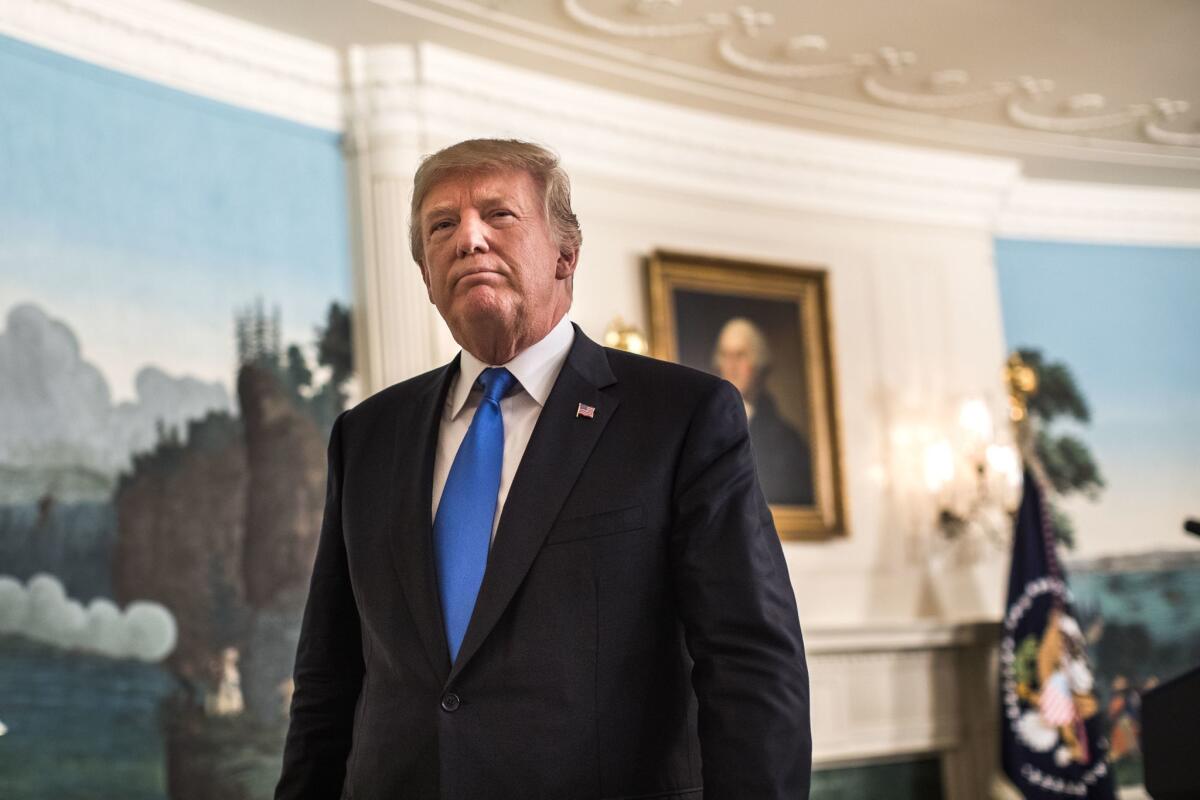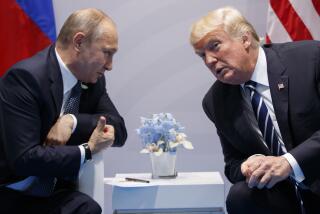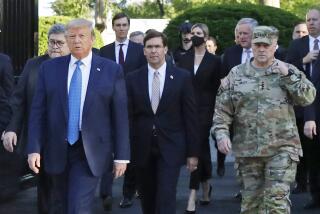Op-Ed: Trump is playing a reckless game with the global nuclear arsenal

When the announcement came May 21 that the U.S. was withdrawing from the 34-nation Open Skies Treaty, President Trump was asked if he could explain why our government would exit an agreement that allowed for reconnaissance flights to check military forces and activities in member nations. Here’s a charitable paraphrase of his characteristically incoherent response: Russia didn’t adhere to the treaty, and anyway, when we pull out, Russia will want to make a new deal with him. In short: “I can do better,” without explaining how or even why it’s necessary.
Beginning with President Eisenhower, 11 American presidents have sought to negotiate arms control agreements with Russia and other countries to reduce the risk of conflict, including nuclear war. Trump, who has surrounded himself with a string of historically anti-arms control advisors, is systematically dismantling what he dismissively refers to as “old” agreements, with promises but no visible plans to replace them.
The always-telling question “Cui bono?” applies here. Who benefits from a policy of U.S. withdrawal from arms control commitments combined with nothing clearly in the works to take their place? The chief beneficiaries of this pattern of destruction are the United States’ current and potential competitors — chiefly China and Russia — which are increasingly free to arm themselves as they please and even to improve their nuclear arsenals under the cover of the Trump administration’s reckless incompetence.
Over seven administrations, the two of us worked in the State Department and the White House with officials in both parties to build arms control regimes, bilateral and multilateral, that reduced the risk of war, limited the cost of the arms race and increased the accuracy of our national security intelligence. We know that no arms control treaty is perfect — few things in life are — but we are better off with them than without them.
All of the agreements the U.S. has worked hard to put in place include mechanisms for addressing concerns over compliance, from purely technical implementation issues to fundamental violations. They allow for discussion and contain agreements to update the terms, which has happened routinely.
Prior to and during the Trump era, Russian actions have raised questions about that country’s full compliance with some of these accords. But in every case, it has been in the interest of the United States, and of our allies, to address those concerns using the treaties’ compliance machinery, rather than to withdraw.
In short, a hard-headed assessment of the security terrain should have concluded that these agreements still have value, combining transparency and predictability along with verifiable limits that have tempered the arms race. Abandoning America’s arms control commitments — as the Trump administration has done by leaving the Iran nuclear deal, the Intermediate-range Nuclear Forces treaty and now the Open Skies accord — simply allows our adversaries the leeway to engage in previously restricted or banned activities that can threaten America’s security. That is what Iran is doing in the aftermath of the broken nuclear deal; and that is what Russia may do now that the U.S. has quit the INF and Open Skies treaties.
Ripping up agreements, walking away from them and mumbling vagaries about new deals someday, may define “America first” for some. But in the next few years without agreements in force (treaties take years, sometimes decades to negotiate), there will be instability and opportunities for Russia, China and other U.S. adversaries to develop more destructive nuclear capabilities. Our allies have to wonder if we have completely lost our minds.
Other than announcing an invitation to talk with the Russians, and plans for a singular meeting between mid-level U.S. and Russian officials, there are few signs that the administration has actually begun preparing the detailed, complex analyses and negotiating strategies required to update the pacts it pretends must be modified. To make matters worse, there are few indications that the U.S. military can use the end of limitations imposed by the treaties to deploy new weapons. Nor has it bothered to explain why this would even be in our interests, given that Russia and China could take full advantage.
What is next up on the Trump chopping block? How about refusing to extend the New START Treaty limiting U.S. and Russian strategic nuclear forces, or “unsigning” the Comprehensive Nuclear Test Ban Treaty? On the heels of the announcement about the Open Skies treaty, the Washington Post reported that senior officials discussed resuming live nuclear tests for the first time since 1992. Because the U.S. has conducted more nuclear tests than any other country, and has built an impressive program to sustain its nuclear stockpile without testing, Russia and China stand to gain more than we do if testing resumes. Moreover, it could well take another 40 years to conclude another test ban, replicating the efforts from Eisenhower to Clinton.
America’s arms control agreements have been a bipartisan success story accomplished over many years. On balance, the web of limitations, constraints and norms they created reinforced the effectiveness of each individually. They reduced uncertainty and risk, limited costs and made conflict less likely. Creating a world scattered with the ruins of arms control regimes, especially given the ambitions of Moscow and Beijing, means years of living dangerously. With thanks to Donald Trump.
Richard A. Clarke was the assistant secretary of State for political military affairs and special advisor to the president from 1989 to 2002. Steven Andreasen was the National Security Council’s staff director for defense policy and arms control from 1993 to 2001.
More to Read
A cure for the common opinion
Get thought-provoking perspectives with our weekly newsletter.
You may occasionally receive promotional content from the Los Angeles Times.










